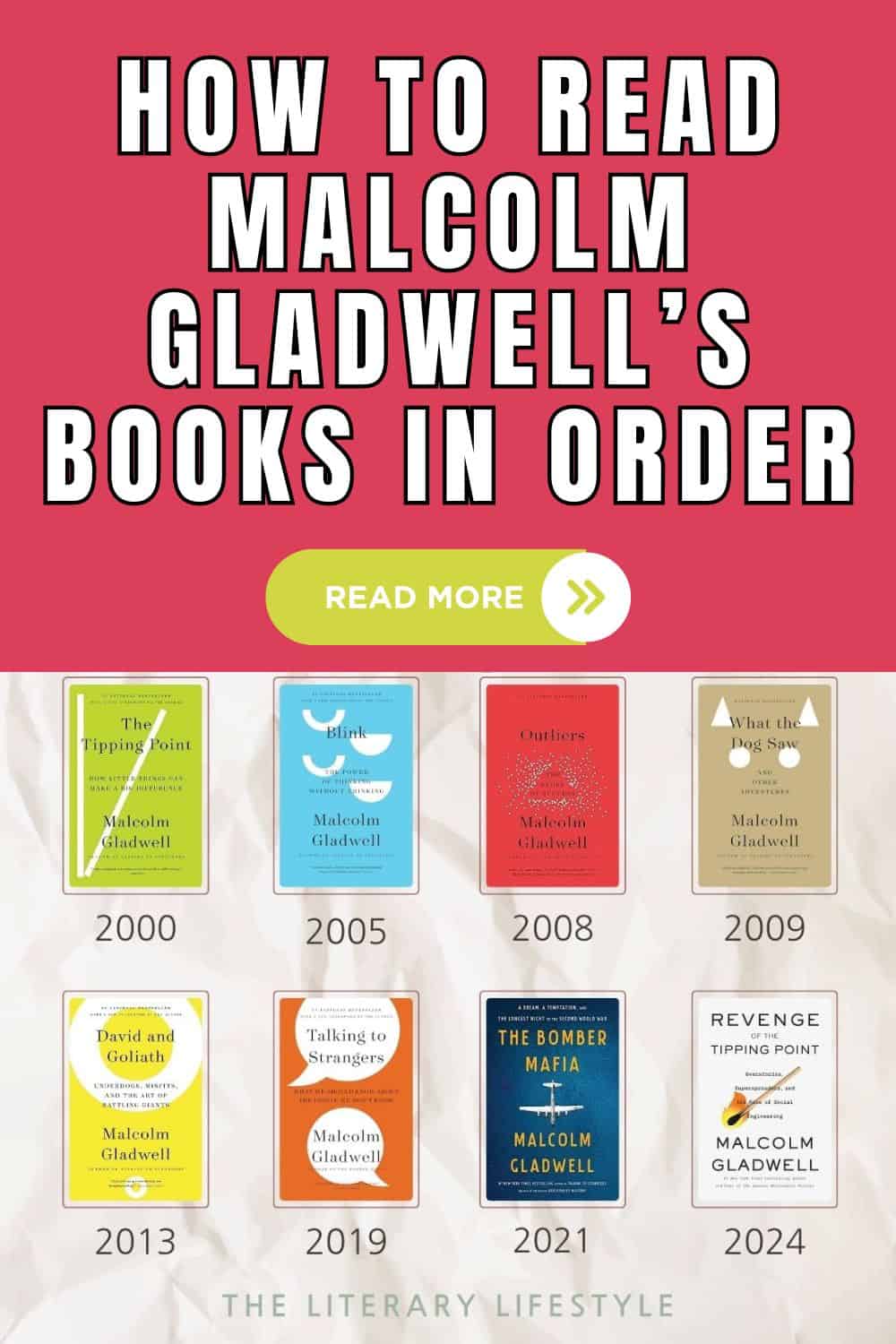Learn how to read Malcolm Gladwell’s books in order of publication and popularity. You’ll find out why I recommend you start with The Tipping Point, what book is best for what type of person, and so much more. You’ll get walk away with a thought-provoking reading list from this bestselling social scientist. Let’s get literary!

Malcolm Gladwell’s Books in Order
Publication Order

- The Tipping Point: How Little Things Can Make a Big Difference (2000)
- Blink: The Power of Thinking Without Thinking (2005)
- Outliers: The Story of Success (2008)
- What the Dog Saw and Other Adventures (2009)
- David and Goliath: Underdogs, Misfits, and The Art of Battling Giants (2013)
- Talking to Strangers: What We Should Know About the People We Don’t Know (2019)
- The Bomber Mafia: A Tale of Innovation and Obsession (2021)
- Revenge of The Tipping Point (2024)
Note: Malcolm Gladwell has also published two audio recordings, I Hate the Ivy League: Riffs and Rants on Elite Education (2022) and Miracle and Wonder: Conversations with Paul Simon (2023).
Ranked by Popularity
If you prefer to read Malcolm Gladwell’s books in order of popularity, below they are ranked from most popular (#1) to least popular (#7) below, based on the number of GoodReads reviews they have to date.
- Most Popular (millions sold): The Tipping Point: How Little Things Can Make a Big Difference
- Outliers: The Story of Success
- Blink: The Power of Thinking Without Thinking
- Talking to Strangers: What We Should Know About the People We Don’t Know
- David and Goliath: Underdogs, Misfits, and The Art of Battling Giants
- What the Dog Saw and Other Adventures
- The Bomber Mafia: A Tale of Innovation and Obsession
- Revenge of The Tipping Point (but keep in mind this book is new in 2024 and hasn’t had the same opportunity to garner readings and ratings)
Reading Tips: Why You Should Read Malcolm Gladwell’s Books
TIPS
- WHY READERS LOVE GLADWELL: Malcolm Gladwell, the bestselling author of millions of copies of books, is popular because he uses captivating storytelling to share social science data, and because he often takes things that seem familiar and offers unexpected data about them.
- RECOMMENDED READING ORDER: Malcolm Gladwell’s books are standalone books that can be read in any order. You may wish to start with his first and most popular book to date, The Tipping Point, which has sold millions of copies over two decades. It explores the moment when an idea, trend, or social behavior crosses a threshold, and then tips, spreading like wildfire. His new book, 2024’s Revenge of The Tipping Point offers a new volume discussing recent moments.
- METHODOLOGY: Below are more details about each of Malcolm Gladwell’s books, what makes them memorable, who should read each one, and more. Malcolm Gladwell is my husband’s favorite author, and I have both read several of his books and taken his MasterClass. We share our combined insights to guide your reading below.
The Tipping Point: How Little Things Can Make a Big Difference (2000)
The Tipping Point has sold millions of copies and remains Malcolm Gladwell’s most popular book to date. It explores the moment when an idea, trend, or social behavior crosses a threshold, and then tips, spreading like wildfire.
Through a series of compelling narratives and case studies, from Paul Revere to Six Degrees of Kevin Bacon, Gladwell illustrates how small actions can cause dramatic effects. He introduces concepts such as “The Law of the Few,” “The Stickiness Factor,” and “The Power of Context” to explain why some ideas soar and others sink.
This debut introduced legions of readers to Gladwell’s characteristic writing style: making social science arguments through engaging storytelling that’s backed by data.
I often recommend this book for men, as it’s my husband’s (and many other men’s) favorite book. A few takeaways we think readers will appreciate as much as we did are the power of being a networker and the concept of “sticky” ideas, both of which can be applied in your business life.
Blink: The Power of Thinking Without Thinking (2005)
Blink dives into snap judgments and quick decisions, arguing that they are often as accurate as those made after deliberation. Exploring things like the assessment of sculptures and the strategies of military generals, Gladwell examines both the strengths and weaknesses of quick thinking and when it can be trusted.
This book has applications in your work and personal life since we make so many daily decisions. It’s most well-known for Gladwell’s theories on “thin-slicing”—how we make quick judgments and draw conclusions from very small amounts of information.
This takeaway has impacted my husband’s decision-making at work and inspired him to study behavioral psychology further. We think it will also help other decision-makers out there learn when to trust their guts.
Outliers: The Story of Success (2008)
Outliers offers surprising statistics about what contributes to success. Gladwell argues that personal achievements are not just the result of talent and/or effort but also luck and timing.
He relies on stories about people like Bill Gates and the number of Canadian hockey players born in the first months of the year, and he introduces concepts like the “10,000-Hour Rule,” which states that expertise requires at least ten thousand hours of practice.
I’ve taken the 10,000-Hour Rule away with me in practice. This book helped my husband understand factors that could drive success beyond being smart or hardworking. Based on this, we recommend this particular book to the ambitious achievers out there. It’s a very grounding way to look at your goals.
What the Dog Saw and Other Adventures (2009)
What the Dog Saw and Other Adventures is a compilation of Gladwell’s writings on a wide range of subjects, from the secrets of a perfect pitch to the intricacies of dog training from the dog’s perspective.
Unlike Gladwell’s other books, which focus on a single theme throughout, this one showcases many of Gladwell’s interests.
We only recommend this one if you don’t mind a book that strays from one cohesive theme and jumps around to many different concepts. Gladwell’s usual “deep dives” are where he excels.
David and Goliath: Underdogs, Misfits, and The Art of Battling Giants (2013)
David and Goliath looks at power and how weaknesses can often be sources of unexpected strength. Gladwell explores various scenarios in which people facing disadvantages overcome seemingly insurmountable obstacles by turning their limitations into advantages.
I found it to be a uniquely thoughtful take on what contributes to success. My husband said this is the one book he would consider “required reading” for business people, as it forces you to think about how to become a creative problem solver to succeed. He recommends it to fans of The Innovator’s Dilemma.
Talking to Strangers: What We Should Know About the People We Don’t Know (2019)
Talking to Strangers dives into the misunderstandings that arise when we interact with people we don’t know. Gladwell utilizes high-profile people, from Fidel Castro to Bernie Madoff and Amanda Knox to show the challenges and dangers of misinterpretation. He forces the reader to look at the assumptions and biases hindering our interpersonal interactions to reach a more accurate understanding.
This is a great book for any modern adult to read in either a business or personal context, as miscommunication underlies so many aspects of our world, from social media to politics.
Reading Tip: With the real-life voices of many of the people featured in this book, the audio version was extremely memorable.
The Bomber Mafia: A Tale of Innovation and Obsession (2021)
The Bomber Mafia is a historical narrative centered on innovation and the moral dilemmas of warfare.
It focuses on a group of strategists in the U.S. Air Force during World War II, known as the Bomber Mafia, whose goal was to minimize civilian casualties and bring conflicts to a quicker end through precision bombing. Ultimately, their story examines how technology, vision, and morality intersect during war.
This book is best for those who don’t mind straying from Gladwell’s usual social sciences and into history instead.
Revenge of The Tipping Point (2024)
In Revenge of The Tipping Point, Gladwell returns to the concept that made him famous twenty years ago through analyses of modern events, from the opioid epidemic to college admissions, discrimination, and the power of television.
Fans of The Tipping Point will love this “sequel.” It’s just like the original but with new stories. His thorough analyses of the opioid epidemic throughout the book is especially powerful, and his argument of the persuasiveness of television was so insightful for any argument maker.
About Malcolm Gladwell
about
Malcolm Gladwell is a famous book writer, journalist, and speaker who is known for his deep dives into social science statistics, which he shares through surprising and captivating narratives.
A graduate of the University of Toronto, Trinity College, Gladwell embarked on a journalism career that led him from The American Spectator to The Washington Post, and The New Yorker in 1996.
Gladwell’s breakthrough came with the publication of his first bestselling book in 2000, The Tipping Point. Now, his podcast, Revisionist History, published by his audio content company, Pushkin Industries, also re-examines the past.
Among other accolades, Gladwell has been named one of Time’s 100 most influential people.
Books and Authors Like Malcolm Gladwell
READ – A – LIKES
Generally speaking, Adam Grant’s books remind me most of Malcolm Gladewell’s. While I recommend them all, Originals by Adam Grant would make a great companion read to Outliers. It focuses on characteristics of successful people.
If you loved The Tipping Point, check out Made to Stick by Chip Heath and Dan Heath. It’s based on Gladwell’s concept of stickiness.
For fans of David and Goliath, my husband recommends The Innovator’s Dilemma by Clayton M. Christensen.
Lastly, fans of Talking to Strangers should read Brene Brown’s Braving the Wilderness. It offers thoughtful communication tips in a modern world full of miscommunication.
Recap
This exploration of Malcolm Gladwell’s books in order guided you through a range of non-fiction books that are popular and useful both in your personal life and in your work life.
Gladwell is popular because he uses captivating storytelling to share social science data and because he often takes familiar subjects and offers unexpected data about them.
If you’re unsure where to start or what to read next, our top recommendation is his first and most popular book, The Tipping Point. Blink is another great pick because it introduces the reader to one of Gladwell’s most well-known concepts, “thin-slicing.”

remember, it’s a good day to read a book. – jules











